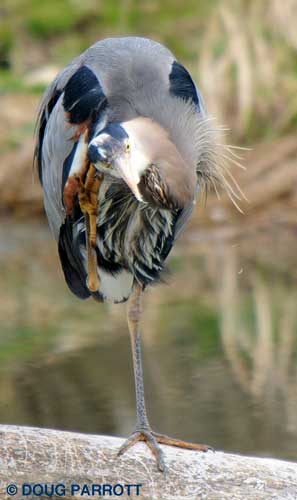 Great Blue Herons often look to me like they just stuck a toe in an electric socket. Foom! and their feathers jut out in shock. Other times, they remind me of Emperor Joseph II’s criticism of Mozart’s new opera. To paraphrase: “There are simply too many feathers. Just cut a few and it will be perfect.”
Great Blue Herons often look to me like they just stuck a toe in an electric socket. Foom! and their feathers jut out in shock. Other times, they remind me of Emperor Joseph II’s criticism of Mozart’s new opera. To paraphrase: “There are simply too many feathers. Just cut a few and it will be perfect.”
But as Mozart was completely unable to cut a note without ruining the perfection of his opera, a heron needs every one of its feathers, too, raggedy or not. Some it needs to keep warm. Some it hopes will attract a mate. Some it uses to intimidate a rival. Some are to fly, some to steer. Some smooth out the contours of the heron’s wings to improve air flow. All these feathers are piled onto the bird – in rows, in stacks, in heaps, in single plumes. There are so many you could never hope to count them all.
The feathers take a lot of care. They must be oiled and smoothed, fluffed up and patted down. Sometimes, the feathers itch, and the heron must raise one foot in a careful balancing act and scratch the offending area. Sometimes, the feathers wear out, and then the bird must molt.
All birds molt their feathers, usually at least once a year, but they do it on their own schedule. Some birds molt just before they leave to head south on their long flight to their winter territory. Some wait till they’re home for the winter and then molt. Some molt soon after the babies leave the nest, when the parents have time to draw a breath. Many males, especially ducks, molt out of their breeding plumage shortly after mating – they need to get inconspicuous as quickly as possible to evade predators.
Herons never seem to molt. On the contrary, they always seem to carry an overabundance of supply. Intellectually, you know they must lose a feather here and there, now and then. But like all the best performers, they never let you see them drop a note.
